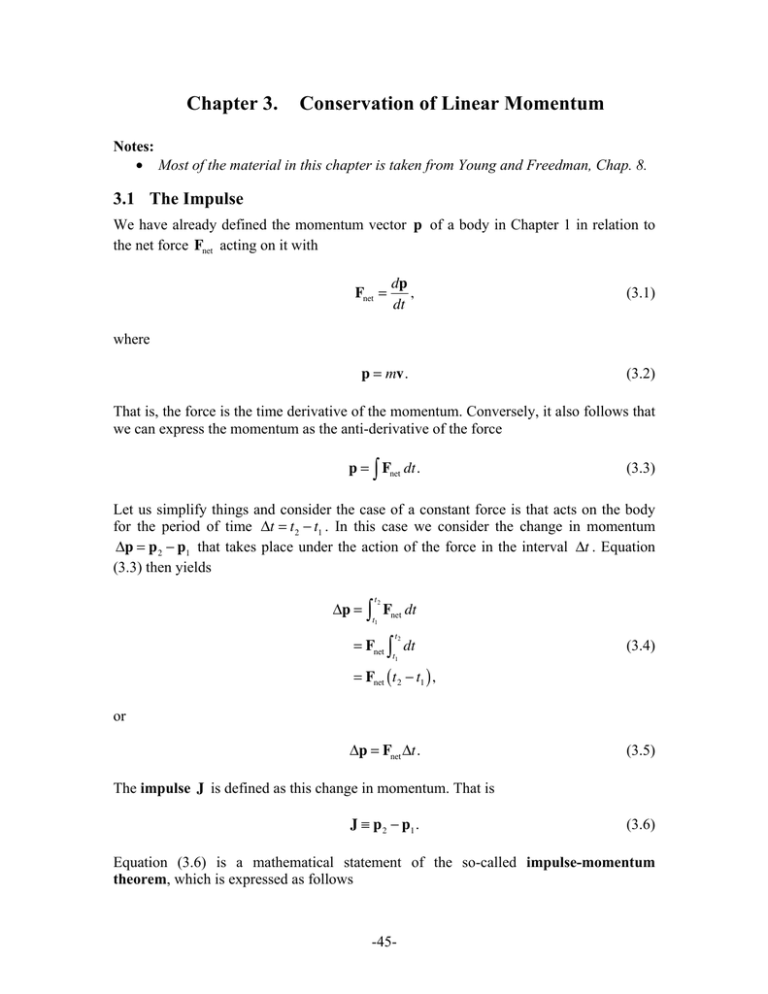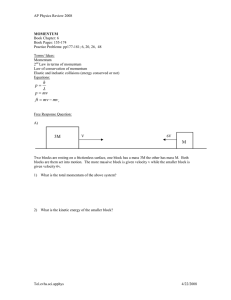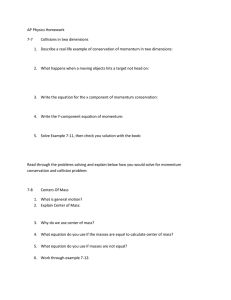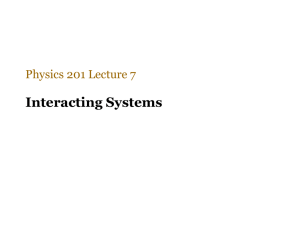
Chapter 3.
Conservation of Linear Momentum
Notes:
• Most of the material in this chapter is taken from Young and Freedman, Chap. 8.
3.1 The Impulse
We have already defined the momentum vector p of a body in Chapter 1 in relation to
the net force Fnet acting on it with
Fnet =
dp
,
dt
(3.1)
where
p = mv.
(3.2)
That is, the force is the time derivative of the momentum. Conversely, it also follows that
we can express the momentum as the anti-derivative of the force
p = ∫ Fnet dt .
(3.3)
Let us simplify things and consider the case of a constant force is that acts on the body
for the period of time Δt = t 2 − t1 . In this case we consider the change in momentum
Δp = p 2 − p1 that takes place under the action of the force in the interval Δt . Equation
(3.3) then yields
t2
Δp = ∫ Fnet dt
t1
t2
= Fnet ∫ dt
(3.4)
Δp = Fnet Δt.
(3.5)
t1
= Fnet ( t 2 − t1 ) ,
or
The impulse J is defined as this change in momentum. That is
J ≡ p 2 − p1 .
(3.6)
Equation (3.6) is a mathematical statement of the so-called impulse-momentum
theorem, which is expressed as follows
-45-
The change in momentum of a body during a time interval equals the impulse of the net
force that acts on the particle during that interval.
Although we focused on the case where a constant force is at play, the same result applies
in the more general situation when the force can vary in magnitude and orientation. In
that case we write
t2
J = ∫ Fnet dt
t1
=∫
t2
t1
dp
dt
dt
(3.7)
t2
= ∫ dp
t1
= p 2 − p1 .
Even when the force is variable it is possible, however, to define an average force such
that (following equations (3.5) and (3.7))
J = Fave ( t 2 − t1 ) .
(3.8)
It is interesting to note the similarity between in the respective forms of the work W
done by a net force Fnet over a displacement Δr and the impulse J resulting from that
same force over a time interval Δt . That is,
2
W = ∫ Fnet ⋅ dr
1
= K 2 − K1
2
J = ∫ Fnet dt
(3.9)
1
= p 2 − p1 .
Just as we had that the final kinetic energy of the object equals the sum of the initial
kinetic energy and the work done by the net force on the object
K 2 = K1 + W ,
(3.10)
the final momentum equals the sum of the initial momentum and the impulse
p 2 = p1 + J.
(3.11)
3.1.1 Exercises
1. (Prob. 8.7 in Young and Freedman.) A 0.0450 kg golf ball initially at rest is given a
speed of 25.0 m/s when a club strikes it. If the club and ball are in contact for 2.00 ms,
-46-
what average force acts on the ball? Is the effect of the ball’s weight during the time of
contact significant? Why or why not?
Solution.
If the direction of the final velocity of the ball is along the positive x-axis , then vx1 = 0
and vx 2 = 25 m/s . From equation (3.8) we have
mvx 2 − mvx1
t 2 − t1
0.0450 kg ⋅ 25 m/s
=
2.00 × 10 −3 s
= 562 N.
Fave =
(3.12)
On the other hand, the weight of the ball is w = mg = 0.0450 kg ⋅ 9.80 m/s 2 = 0.441 N .
The force on the ball therefore exceeds the weight of the ball by a factor of more than
1000; the weight of the ball is utterly insignificant.
2. (Prob. 8.12 in Young and Freedman.) A bat strikes a 0.145 kg baseball. Just before
impact, the ball is travelling horizontally to the right at 50.0 m/s, and it leaves the bat
travelling to the left at an angle of 30 above horizontal with a speed of 65.0 m/s. If the
ball and bat are in contact for 1.75 ms, find the horizontal and vertical components of the
average force on the ball.
Solution.
Let x > 0 and y > 0 be oriented to the right and upward. The impulse components along
these directions are
J x = m ( vx 2 − vx1 )
= 0.145 kg ⋅ ⎡⎣ −65 cos ( 30 ) − 50 ⎤⎦ m/s
= −15.4 N ⋅s
(
J y = m vy2 − vy1
)
= 0.145 kg ⋅ ⎡⎣ 65sin ( 30 ) − 0 ⎤⎦ m/s
= 4.71 N ⋅s.
The corresponding components of the average force are
-47-
(3.13)
Jx
Δt
−15.4 N ⋅s
=
1.75 × 10 −3 s
= −8800 N
Fave,x =
(3.14)
and
Jy
Δt
4.71 N ⋅s
=
1.75 × 10 −3 s
= 2690 N.
Fave,y =
(3.15)
3.2 Conservation of Linear Momentum
Given that considerations of equation (3.10) led us to the principle of conservation of
energy in Chapter 2, and that equation (3.11) for the momentum and impulse has a form
that is basically similar to that of equation (3.10), it is then reasonable to expect that we
would also have conservation of the linear momentum (for an isolated system).
To show this we consider an isolated system for which all the forces involved in the
dynamics of the set of particles contained in the system are internal to it. That is, internal
forces denote interactions between particles (according to Newton’s Third Law), as
opposed to external forces, which act on the system as a whole. For example, let us
assume that an isolated system is made of only two particles, which we denote as “1” and
“2”. According to Newton’s Third Law if F12 is the net internal force that particle “1”
applies on particle “2”, then F21 = −F12 and
F12 + F21 = 0.
(3.16)
If we now use Newton’s Second Law as expressed in equation (3.1), then we can write
dp 2 dp1
+
dt
dt
d
= ( p 2 + p1 )
dt
= 0.
F12 + F21 =
(3.17)
But since the total linear momentum p tot of the system is
p tot = p1 + p 2 ,
it follows that
-48-
(3.18)
dp tot
=0
dt
(3.19)
p tot = constant.
(3.20)
or
Although we only considered two particles, this result is applicable to any number of
particles, and we are lead to the principle of conservation of linear momentum
If no net external force is acting on a system (i.e., an isolated system), then the total
linear momentum of the system is constant.
For an isolated system containing N we would have
N
p tot = ∑ p i
i=1
(3.21)
= constant.
It should be noted that this result relies entirely on Newton’s Third Law, as stated in
equation (3.16). Because this equation does not make any requirement on the nature of
the internal forces involved (i.e., they do not need to be “central”, or being directed at the
centers of the particles), it is often called the “weak form” of Newton’s Third Law. We
will use another stronger version of this law to derive the principle of conservation of
angular momentum in the next chapter.
3.2.1 Exercises
3. (Prob. 8.18 in Young and Freedman.) A 68.5-kg astronaut is doing a repair in space on
the orbiting space station. She throws a 2.25-kg tool away from her at 3.20 m/s relative to
the space station. With what speed and in what direction will she begin to move?
Solution.
Let us assume that the tool is thrown in the positive x direction and that its velocity is
denoted by vBx ; the astronaut’s velocity is vAx . Defining by “1” and “2” the initial and
final conditions of the astronaut-tool system we have vAx1 = vBx1 = 0 and by the principle
of conservation of the linear momentum we write
mA vAx1 + mB vBx1 = mA vAx 2 + mB vBx 2
= 0.
It therefore follows that
-49-
(3.22)
mB
vBx 2
mA
2.25 kg
=−
3.20 m/s
68.5 kg
= −0.105 m/s
vAx 2 = −
(3.23)
and the astronaut starts moving opposite to the direction in which she throws the tool.
4. (Prob. 8.23 in Young and Freedman.) Two identical 1.50-kg masses are pressed against
opposite ends of a light spring of force constant 1.75 N/cm, compressing it by 20.0 cm
from its normal length. Find the speed of each mass when it has moved free of the spring
on a frictionless horizontal table.
Solution.
The initial and final conditions of the system are shown in Figure 1. Since the linear
momentum is conserved and vA1 = vB1 = 0 , it is clear that
mA v A1 + mB vB1 = mA vA2 + mB vB2
=0
(3.24)
and vA2 = −vB2 (because mA = mB ). But the system is also conservative since no energy is
dissipated. We can therefore write
1 2 1 2 1 2 1 2 1 2 1 2
mvA1 + mvB1 + kx1 = mvA2 + mvB2 + kx2
2
2
2
2
2
2
(3.25)
1 2 1 2 1 2
kx1 = mvA2 + mvB2
2
2
2
2
= mvA2 .
(3.26)
or, since x2 = 0 ,
We then find that
vA2 = x1
k
2m
= 0.200 m
= 1.53 m/s.
-50-
175 N/m
2 ⋅1.50 kg
(3.27)
8.23.
IDENTIFY: The momentum and the mechanical energy of the system are both conserved. The mechanical
energy consists of the kinetic energy of the masses and the elastic potential energy of the spring. The
potential energy stored in the spring is transformed into the kinetic energy of the two masses.
SET UP: Let the system be the two masses and the spring. The system is sketched in Figure 8.23, in its
initial and final situations. Use coordinates where + x is to the right. Call the masses A and B.
Figure 8.23
EXECUTE:
Figure 1 – The initial and final conditions for the
P1x = P2xsystem
so 0 = (1of
.50Problem
kg)(−v A ) +4.(1.50 kg)(vB ) and, since the masses are equal,
v A = vB .
Energy conservation says the potential energy originally stored in the spring is all converted into kinetic
1 kx 2 = 1 mv 2 + 1 mv 2 . Since v = v , this equation gives
A 2
B
A
B
2 1
2
3.3energy
Collisions
of the masses, so
Collisions can
be thought175
of N/m
as special cases where internal forces are responsible for the
k
v A = interactions
x1
= (0.200occurring
= 1.53 m/s.
m)
strong
between
the bodies composing the system. There are two
2m
2(1.50 kg)
different,
broad classes of collisions: elastic and inelastic collisions. The distinction
EVALUATE: If the objects have different masses they will end up with different speeds. The lighter one
between
these
two speed,
classes
the
fact
that conservation
will have the greater
sinceresides
they endwith
up with
equal
magnitudes
of momentum.of kinetic energy is
achieved
in
an
elastic
collision
whereas
it
is
not
in
an
inelastic
collision.
Inexpression,
other words,
8.24.
IDENTIFY: In part (a) no horizontal force implies Px is constant. In part (b) use
the energy
theEq.
internal
conservative
in the
first
case, but are not in the other.
7.14, toforces
find theare
potential
energy initially
in the
spring.
SET UP: Initially both blocks are at rest.
It is also essential to remember that experiments show that linear momentum is always
conserved in a collision, irrespective of whether kinetic energy is conserved or not.
3.3.1 Elastic Collisions
If we consider a collision between two bodies of masses and velocities mA and v A , and
mB and v B , respectively, then we have for an elastic collision
Figure 8.24
EXECUTE: (a)
1
1
1
1
2
2
2
2
mA vA1
+ mB vB1
= mA vA2
+ mB vB2
2
2
2
2
m Av A1x + mB vB1x = m Av A2 x + mB vB 2 x
mA v A1 + mB v B1 = mA v A2 + mB v B2 ,
(3.28)
0 = m Av A2 x + mB vB 2 x
mB
3.00 kgthe physical conditions before and after the
where the subscripts
denote
v A2 x =“1”
− and
vB“2”
(+1.20 m/s) = −3.60 m/s
2x = −
m A use the 1fact
.00 kg
collision. We will now make
that we expect that the laws of physics are the
Block
has ainertial
final speed
of 3.60 m/s,
and moves
the opposite direction
to B. 1.1.2 in Chapter 1).
same
in Aany
reference
frame
(seeoff
thein discussion
in Section
(b)
Use
energy
conservation:
K
+
U
+
W
=
K
+
U
.
1
1
other
We therefore choose a new reference
frame2 that2 is moving with the initial velocity v B1 of
Only the spring force does work so Wother = 0 and U = U el .
the second object. That is, in that frame the velocity become
K1 = 0 (the blocks initially are at rest)
U 2 = 0 (no potential energy is left in the w
spring)
=v
A1
A1
− v B1
B1
B1
B1
2 1
2
K 2 = 12 m Av 2A2 + 12 mB vB2 2 = 12 (1w.00 kg)(3
= v .60− m/s)
v =+ 02 (3.00 kg)(1.20 m/s) = 8.64 J
U1 = U1,el the potential energy stored in the compressed spring.
Thus U1,el = K 2 = 8.64 J
w A2 = v A2 − v B1
w B2 = v B2 − v B1 .
(3.29)
© Copyright
Education,body
Inc. Allis
rights
reserved. at
Thisrest
material
protected
under all
copyright
laws equations
as they currently
exist.
That2012
is,Pearson
the second
initially
in isthis
inertial
frame.
The
for
the
No portion of this material may be reproduced, in any form or by any means, without permission in writing from the publisher.
conservations of kinetic energy and linear momentum in that inertial frame are
-51-
1
1
1
2
2
2
mA wA1
= mA wA2
+ mB wB2
2
2
2
mA w A1 = mA w A2 + mB w B2 ,
(3.30)
which can be transformed to
2
2
2
mB wB2
= mA ( wA1
− wA2
)
mB w B2 = mA ( w A1 − w A2 ) .
(3.31)
The first of equations (3.31) can further be rewritten as
mB w B2 ⋅ w B2 = mA ( w A1 − w A2 ) ⋅ ( w A1 + w A2 ) ,
(3.32)
and upon insertion of the second of equations (3.31) on the left-hand side of equation
(3.32) becomes
mA ( w A1 − w A2 ) ⋅ w B2 = mA ( w A1 − w A2 ) ⋅ ( w A1 + w A2 ) .
(3.33)
It therefore follows that
w B2 = w A1 + w A2 ,
(3.34)
We can in turn insert this result back into equation (3.32) to get
mB ( w A1 + w A2 ) = mA ( w A1 − w A2 )
(3.35)
or an expression for the final velocity for the first body as a function of its initial velocity
w A2 =
mA − mB
w A1 .
mA + mB
(3.36)
The final velocity of the second body can also be determined by inserting equation (3.36)
into equation (3.34) with
w B2 =
2mA
w A1 .
mA + mB
(3.37)
It is interesting to study some limiting cases of collisions. For example, when mA mB
we find that
w A2 −w A1
w B2 0.
-52-
(3.38)
That is, the light, first body bounces off the heavy second body and reverses it velocity;
the heavy body remains stationary. On the other hand, if we have mA mB , then
w A2 w A1
w B2 2w A1 .
(3.39)
The heavy, first body keeps going unimpeded by the light second body, which starts
moving at twice the initial velocity of the heavy body. A few moments of thoughts should
convince you that these two examples are consistent with one another.
Another interesting case happens when mA = mB . We then find that
w A2 = 0
w B2 = w A1 .
(3.40)
That is, the particles exchange their velocities.
We now come back to equation (3.34) and rewrite it as
w A1 = w B2 − w A2 ,
(3.41)
and we now return to our original inertial frame. That is, transform back the velocities
with equations (3.29) to get the important result
v A1 − v B1 = − ( v A2 − v B2 ) .
(3.42)
Equation (3.42) (or equation (3.41), for that matter) establishes the fact in an elastic
collision the relative velocity between the two bodies has the same magnitude (but is
reversed) before and after the collision. One can readily verify that the three cases we
just studies (i.e., equations (3.38), (3.39), and (3.40)) all agree with equation (3.42).
3.3.2 Completely Inelastic Collisions
We already mentioned that inelastic collisions do not conserve kinetic energy. A special
case can be studied when the two bodies join and stick together after the collision; these
are called completely inelastic collisions. We now have, using again our inertial frame
where the second body is initially at rest,
w A2 = w B2 ≡ w 2 .
(3.43)
And the principle of conservation of linear momentum allows us to write
mA w A1 = ( mA + mB ) w 2 ,
-53-
(3.44)
or
w2 =
mA
w A1 .
mA + mB
(3.45)
We can now verify that kinetic energy is lost because of the collision by calculating the
kinetic energies before and after the interaction
1
2
mA wA1
2
1
K 2 = ( mA + mB ) w22
2
1 mA2
2
=
wA1
.
2 mA + mB
K1 =
(3.46)
The loss of kinetic energy is made evident by the ratio
K2
mA
=
< 1,
K1 m A + m B
(3.47)
which, as shown here, is always less than unity.
3.3.3 Exercises
5. (Prob. 8.49 in Young and Freedman.) Canadian nuclear reactors use heavy water
moderators in which elastic collisions occur between the neutrons and deuterons of mass
2.0 u (‘u’ is an atomic mass unit). (a) What is the speed of a neutron, expressed as a
fraction of its original speed, after a head-on, elastic collision with a deuteron that is
initially at rest? (b) What is its kinetic energy, expressed a fraction of its original kinetic
energy? (c) How many such successive collisions will reduce the speed of a neutron to
1/59,000 of its original value?
Solution.
Let the positive x direction be that of the initial momentum of the neutron. The mass of a
neutron is mn = 1.0 u and that of a deuteron md = 2.0 u .
(a) We denote by “1” and “2” the conditions before and after the collision, respectively.
We then have from the principles of conservation of energy and linear momentum
1
1
1
2
2
2
mn vnx,1
= mn vnx,2
+ md vdx,2
2
2
2
mn vnx,1 = mn vnx,2 + md vdx,2 .
-54-
(3.48)
Solving these equations was accomplished before in three dimensions and shown to yield
equation (3.36), from which we use only the x-component
mn − md
vnx,1
mn + md
1.0 u − 2.0 u
=
vnx,1
1.0 u + 2.0 u
v
= − nx,1 .
3
vnx,2 =
(3.49)
(b) The neutron kinetic energy after the collision is
1
2
mn vnx,2
2
K n,2 =
1 ⎛v ⎞
= mn ⎜ nx,1 ⎟
2 ⎝ 3 ⎠
K
= n,1 .
9
2
(3.50)
(c) For each collision the speed of the neutron is reduced by a factor of three. So for n
collisions we have
vnx,( n+1)
vnx,1
⎛ 1⎞
=⎜ ⎟
⎝ 3⎠
n
1
=
.
59,000
(3.51)
This implies that
3n = 59,000,
(3.52)
ln ( 3n ) = n ln ( 3)
(3.53)
or
= ln ( 59,000 )
and
n=
ln ( 59,000 )
ln ( 3)
= 10.0.
-55-
(3.54)
3.4 Centre of Mass Motion
Given a system of, say, N particles of potentially different masses, it would be
interesting and perhaps useful to define some mean position for the ensemble using the
position of each particle. Since more massive particles will carry more momentum for a
given velocity it makes sense to weight the position of a particle with its mass. That is,
we define the location of the centre of mass of the system with
N
rcm =
∑m r
i i
i=1
N
∑m
,
(3.55)
i
i=1
where mi and ri are the mass and position of particle i , respectively. Alternatively, we
can write
rcm =
1
M
N
∑m r ,
i i
(3.56)
i=1
with the total mass of the system M = ∑ i=1 mi . We can readily verify that when all the
N
particles have the same mass m = mi , for all i , the centre of mass is simply the average
of the particles’ positions
N
rcm =
∑ mr
i
i=1
N
∑m
i=1
=
m N
∑ ri
Nm i=1
=
1 N
∑ ri ,
N i=1
(3.57)
as would be expected. For solid or rigid bodies, which are composed of a continuum of
microscopic particles (i.e., molecules), the summation of equation (3.56) is replaced by a
three-dimensional integral1
rcm =
1
ρ r d 3r ,
∫
M
1
(3.58)
The definition of a solid body as a continuum of particles, as well as equations (3.58)
and (3.59), are advanced concepts on which you will not be tested.
-56-
with ρ mass density in kg/m 3 and the total mass
M = ∫ ρ d 3r .
(3.59)
It is straightforward to determine the velocity of the centre of mass with
drcm
dt
1 N d ( mi ri )
=
∑
M i=1 dt
v cm ≡
N
1
=
M
dr
∑ mi dti
i=1
1
M
∑m v ,
=
(3.60)
N
i
i
i=1
or again
N
Mv cm = ∑ mi v i .
(3.61)
i=1
But if we consider the total linear momentum of the system of particles P with
N
P = ∑ pi ,
(3.62)
P = Mv cm .
(3.63)
i=1
then we can also conveniently write
That is, the total momentum of the system of particles equals the total mass times the
velocity of the centre of mass. The obvious thing to do now is to proceed with the next
time derivative using equation (3.60) as a starting point
dv cm
dt
1 N
dv
=
mi i
∑
M i=1
dt
a cm ≡
=
1
M
N
∑m a ,
i
i=1
or in the same manner as before
-57-
i
(3.64)
N
Ma cm = ∑ mi a i .
(3.65)
i=1
But we clearly could have proceed differently and defined the force acting on the centre
of mass from Newton’s Second Law and equation (3.63)
dP
dt
d ( Mv cm )
=
dt
dv
= M cm
dt
= Ma cm ,
Fcm =
(3.66)
which is the same as on the left-hand side of equation (3.65). On the other hand, we have
from equation (3.62)
N
Fcm = ∑
i=1
dp i
dt
N
= ∑ Fi .
(3.67)
i=1
However, Fi is the total force acting on particle i that consists of the internal force Fint,i
and the external force Fext,i acting on it. We can therefore write
N
Fcm = ∑ ( Fext,i + Fint,i ).
(3.68)
i=1
But since we know from Newton’s Third Law that internal forces come in pairs that
cancel each other (see equation (3.16)), it follows that the summation over all particles in
equation (3.68) will yield
N
∑F
int,i
= 0.
(3.69)
i=1
We therefore find that
N
Fcm = ∑ Fext,i .
i=1
-58-
(3.70)
That is, a system of particles acted upon by external forces behaves as though all the
mass were concentrated at the centre of mass, while the net force acting on the total mass
is the sum of the external forces acting on the particles composing the system.
3.4.1 Exercises
6. (Prob. 8.110 in Young and Freedman.) A 12-kg shell is launched at an angle of 55.0
above the horizontal with an initial speed of 150 m/s. When it is at its highest point, the
shell explodes into two fragments, one three times heavier than the other. The two
fragments reach the ground at the same time. Assume the air resistance can be ignored. If
the heavier fragment lands back at the same point from which the shell was launched,
where will the lighter fragment land, and how much energy was released in the
explosion?
Solution.
At its highest point, the shell will be moving horizontally; its momentum is then
p = mshellv0 cos (θ ) ,
(3.71)
since there is no net force acting horizontally ( θ = 55 ). This momentum will be
conserved once the shell explodes and
p = m1v1 + m2 v2 ,
(3.72)
where the subscript “1” is for the heavier fragment; it follows that m1 = 3m2 , and
therefore m1 = 9 kg and m2 = 3 kg . If the heavier fragment lands back to the launching
point, then
v1 = −v0 cos (θ ) ,
(3.73)
and
p = mshellv0 cos (θ )
= ( m1 + m2 ) v0 cos (θ )
(3.74)
= −m1v0 cos (θ ) + m2 v2 .
We now have an expression for the speed of the lighter fragment
v2 =
2m1 + m2
v0 cos (θ )
m2
= 7v0 cos (θ ) .
The initial vertical speed of the shell is given by
-59-
(3.75)
v0 y = v0 sin (θ ) ,
(3.76)
and since its vertical speed at its highest point is zero we can determine the time elapsed
between the launch and the apex with
0 = v0 y − gt,
(3.77)
or
t=
v0
sin (θ ) .
g
(3.78)
But this will also be the time it will take for the heavier fragment return to the launch
point; the horizontal distance it thus travels in the backward direction is
x1 = v1t
=−
v02
sin (θ ) cos (θ )
g
=−
v02
sin ( 2θ ) .
2g
(3.79)
Obviously the distance covered by the lighter fragment will be the sum of the horizontal
distance travelled by the shell before it exploded and that it travels after the explosion at
speed v2 . That is,
x2 = x1 + v2t
= (1+ 7 )
v02
sin ( 2θ )
2g
4 ⋅ (150 m/s )
=
sin (110 )
2
9.80 m/s
= 8630 m.
(3.80)
2
Finally, the energy released by the explosion is the energy that is not contained in the
kinetic or potential energies of the fragments right after the explosion
1
1
1
m1v12 + m2 v22 − mshellv02 cos 2 (θ )
2
2
2
2
2
= 24m2 v0 cos (θ )
ΔK =
= 5.33 × 10 5 J.
-60-
(3.81)






